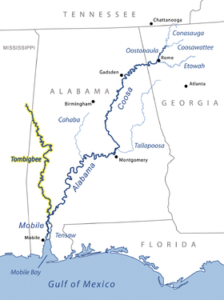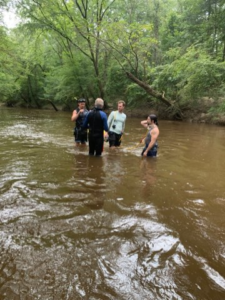The McClung’s Curator of Malacology, Gerry Dinkins, is regularly in demand for his expertise. This is especially true when it comes to assessing the southeastern United States’ freshwater mollusks and the waterways they inhabit.
Last week found Dinkins in lower Alabama, surveying streams in the Tombigbee River’s watershed. Here is his report:

A map of Tombigbee River, courtesy of Wikipedia.
I went down to lower Alabama to conduct surveys for a pipeline project. I was invited to assist the environmental survey team, because I have a federal permit to handle all endangered species of mussels and aquatic snails in Alabama, and I am familiar with the fauna.

Dinkins in a stream with the field crew.
We were surveying for freshwater mussels in stream reaches where the proposed pipeline will cross. All of the waterways were in the lower Tombigbee River drainage, which is one of the most under-surveyed river systems in Alabama. We made significant discoveries in nearly every stream reach we examined. At the same time, I was also able to assist the state malacologist with Alabama’s Department of Natural Resources, who is working on a statewide survey of the aquatic snails of Alabama.

Dinkins measuring mussels during the survey.
The mussels I am measuring in the photograph to the right are of three species: Villosa lienosa (Little Spectaclecase), Villosa vibex (Southern Rainbow), and Strophitus radiatus (Rayed Creekshell). The last species was recently revised, and was split into two new species and one or more yet to be resolved species. The authors of the revision came to UT. They spent some time at the McClung Museum, using specimens from our collection in their research. (Read the paper here.)

The field crew with a female golden silk spider.
While conducting work in the field, my team and I often run in to other interesting creatures. In the picture to the left is a rather common spider that occurs in the lower coastal plain of the southeastern states: Golden Silk Spider (Trichonephila clavipes). It is hard to see here, but as it’s name implies, the spider really does spin a golden web. This is a female. As is typical for a number of spiders (like a Black Widow, for instance), there were several males in the web with her, all much smaller than her.